16+ Smart Home Statistics for 2024
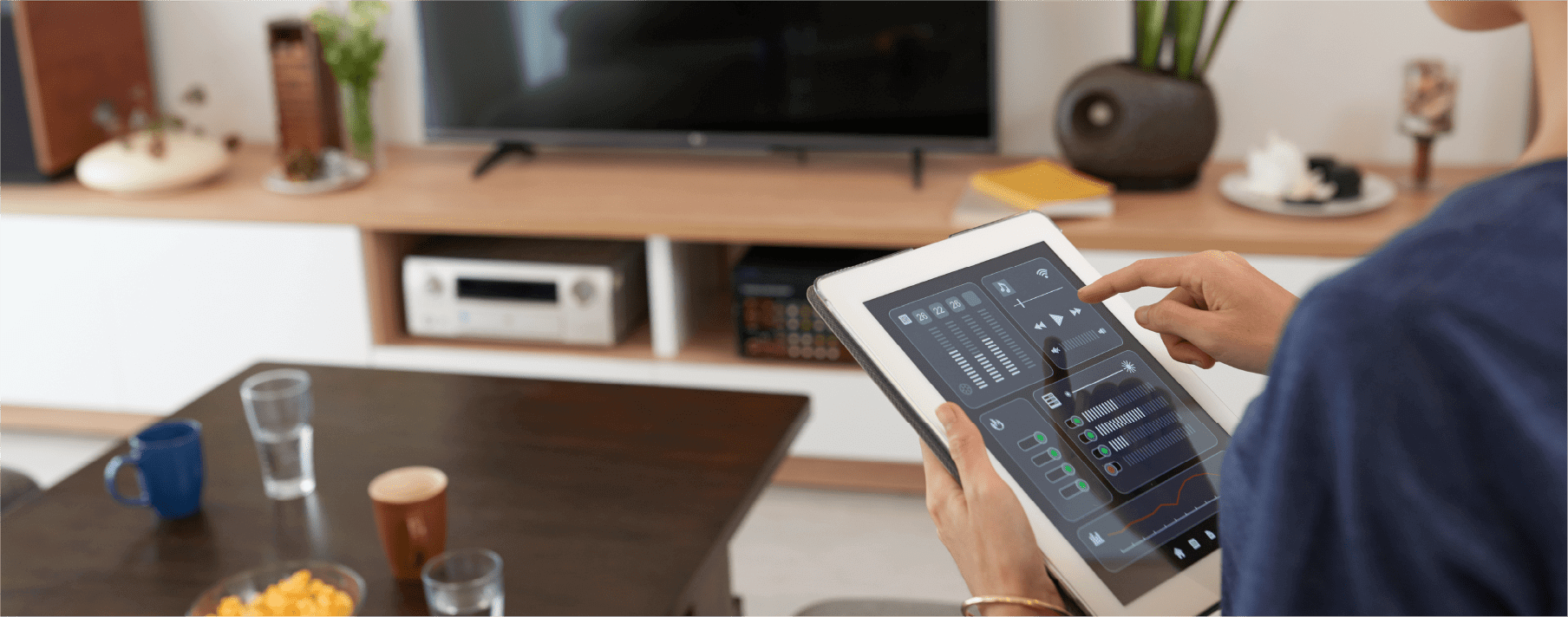
Ten years ago, saying a command into the air and expecting your electronics to listen to you was nothing short of a pipe dream. But now, it's estimated that one in four adults is saying, “Hey Google, set a timer for 15 minutes” or “Alexa, turn on the living room lights” daily. Though, as you probably already know, smart home devices and trends have expanded way beyond smart speakers and plugs. From eco-friendly thermostats to remote control appliances, it’s likely you have at least one of these devices in your home right now. And you aren’t alone.
According to MediaPost, 69% of households in the U.S. have at least one smart device, while 12% of those (about 22 million homes) have several. But deciding which device is right for you can be trickier than it seems. And since smart homes can save money on your insurance premiums, it’s not a decision to take lightly.
Below, we break down the latest smart home statistics to help you decide what products are right for you. From external data points to our own internal survey data, the following smart home statistics cover the industry’s ins and outs and consumer trends.
If you're ready to set up your home with smart devices, check out our smart home kits that come with Hippo home insurance policies or check out our guide to smart home tech for the holiday season, just another way we work to make your life simple.
Smart home statistics: an overview
The smart home industry is no longer a niche category, as its vast array of products are showing up in homes of millennials and baby boomers alike. And while the U.S. is one of the top countries buying up these products, other countries are starting to get in on the action too. It’s predicted that 15% of households worldwide will have a smart home device installed by 2023.
To help understand the motivation behind the rise in smart home purchases, we surveyed 1,000 smart tech users across the nation on what smart home devices they use and why. Here’s what we uncovered.
1. Convenience is the most significant factor in smart home device usage across all demographics (46%).
2. Fire/theft alarm systems rank as the top protective devices by 37% of consumers.
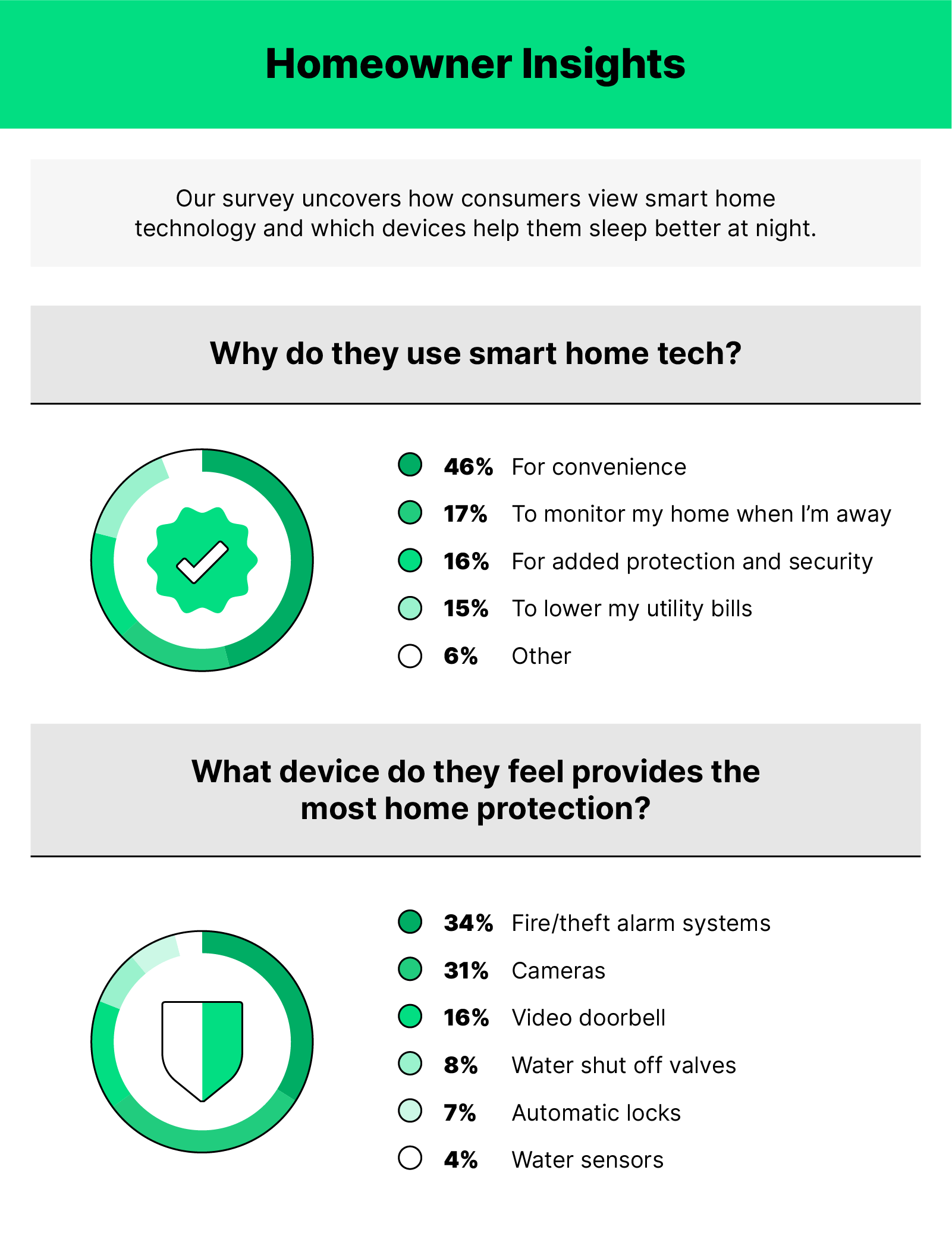
When broken down, there are a few key differences by age and gender.
3. Men are more likely than women to use smart home devices to lower utility bills (17% vs. 13%).
4. Women are more likely than men to use smart home devices for added security (19% vs. 13%).
5. 36% of men and women ages 35–54 think that cameras provide the most protection for their homes.
6. 14% of women ages 25–34 ranked automatic locks as the most protective smart home device.
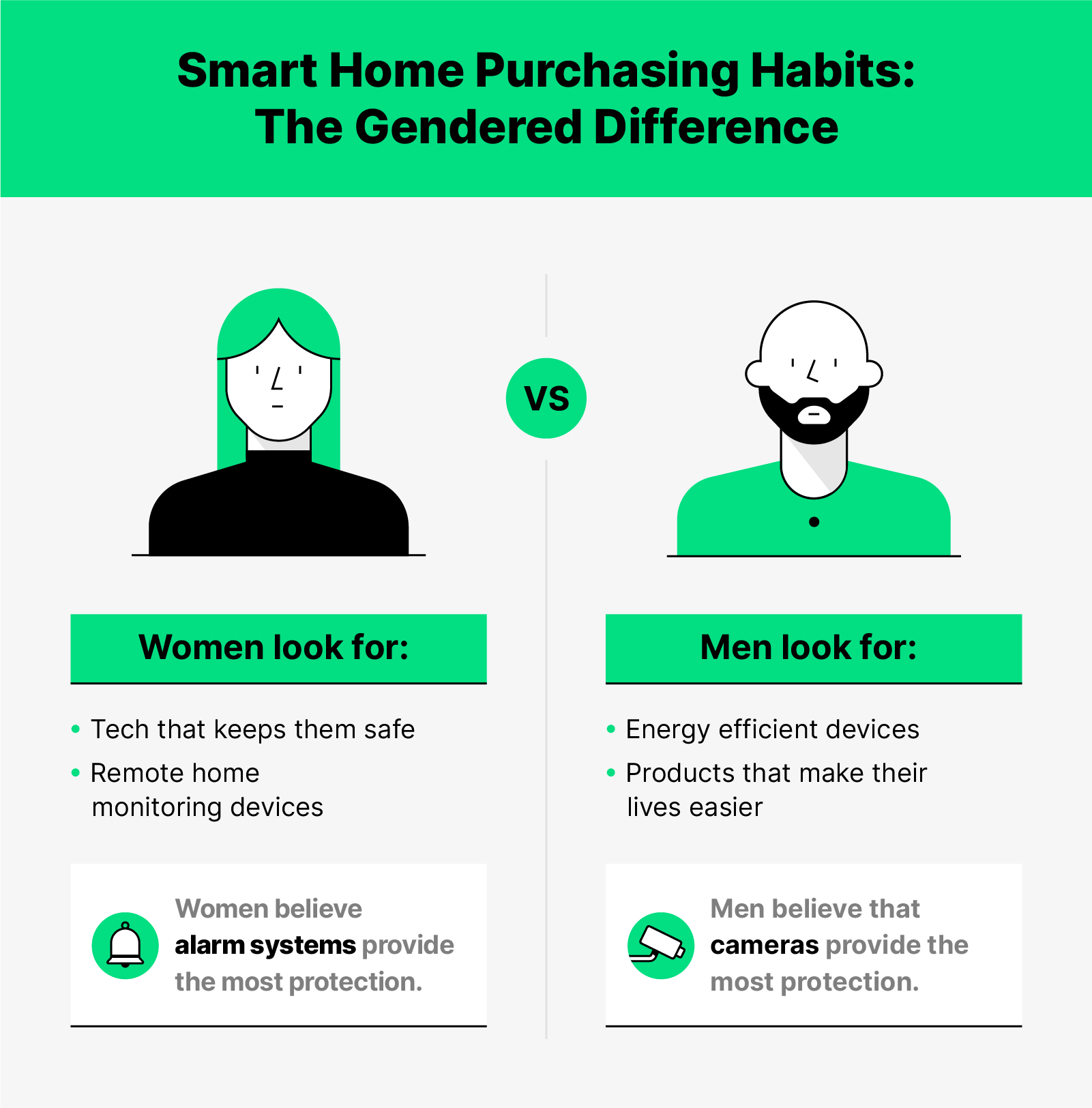
From the most popular products to how these devices affect real estate, here’s what you need to know about this growing industry.
7. Video entertainment devices (like smart TVs) are the most popular, followed by smart speakers and home monitoring products (Digital Media Solutions).
8. By 2025, there are estimated to be 481.9 million smart homes across the world (Statista).
9. The smart thermostat market has grown 30% each year since 2018 (T4).
10. Some of the industry’s biggest companies are Samsung, Ericsson, General Electric, Schneider Electric SE and Honeywell International (Fortune Business Insights).
11. 46% of homeowners want their current or future homes to have smart devices installed (Realtor Magazine).
12. 11% of consumers have at least three or more home control devices (Deloitte).
Prevention and protection: why use smart home devices
While our survey found that most consumers (46%) said that they mainly use smart home devices for the convenience they provide, that wasn’t the only reason behind their purchases.
Consumers also understand that smart devices can provide extra eyes and ears to keep them safe and oversee their home. Home monitoring devices such as security cameras, alarms and video doorbells are the third most popular category in the market. Also, according to our survey:
13. 17% of consumers said that the main reason they use smart devices is to monitor their homes while they’re away.
14. 16% said they mainly use smart home tech for added protection and security.
15. Lowering utility bills is another main draw of this tech, with 15% of consumers noting this was their main reason for purchasing.
Many smart add-ons can save homeowners lots of cash over time. For example, smart water heaters can save you approximately $4,500 over 10 years, while smart thermostats can cut heating and cooling costs by 10% each year.
We also checked in on what particular devices consumers feel provide the most protection for their home.
16. Fire and theft alarm systems came out on top for the most protective device at 34%.
17. This was closely followed by cameras (31%), video doorbells (16%), water shut off valves (8%), automatic locks (7%) and water sensors (4%).
One of the most interesting things we discovered is that consumers understand that water shut off valves provide them with more home protection than automatic locks (8% vs. 7%). While smart locks may seem like the safer choice from a theft perspective, plumbing leaks are actually more common than break-ins. Additionally, water leak detectors can save homeowners up to 10,000 gallons of water waste!
Benefits of smart homes for homeowners
Smart home systems have skyrocketed in popularity in the last few years, for several reasons. In addition to the convenience factor, they also help improve your safety from dangers like theft, fire and appliance malfunctions.
Issues like an oven fire or water leak can cost thousands of dollars in damage, especially if it isn’t caught early on. So it's no surprise that the market is expected to grow to $157 billion by 2023 in the U.S. alone, given the amount of money a homeowner can save over time.
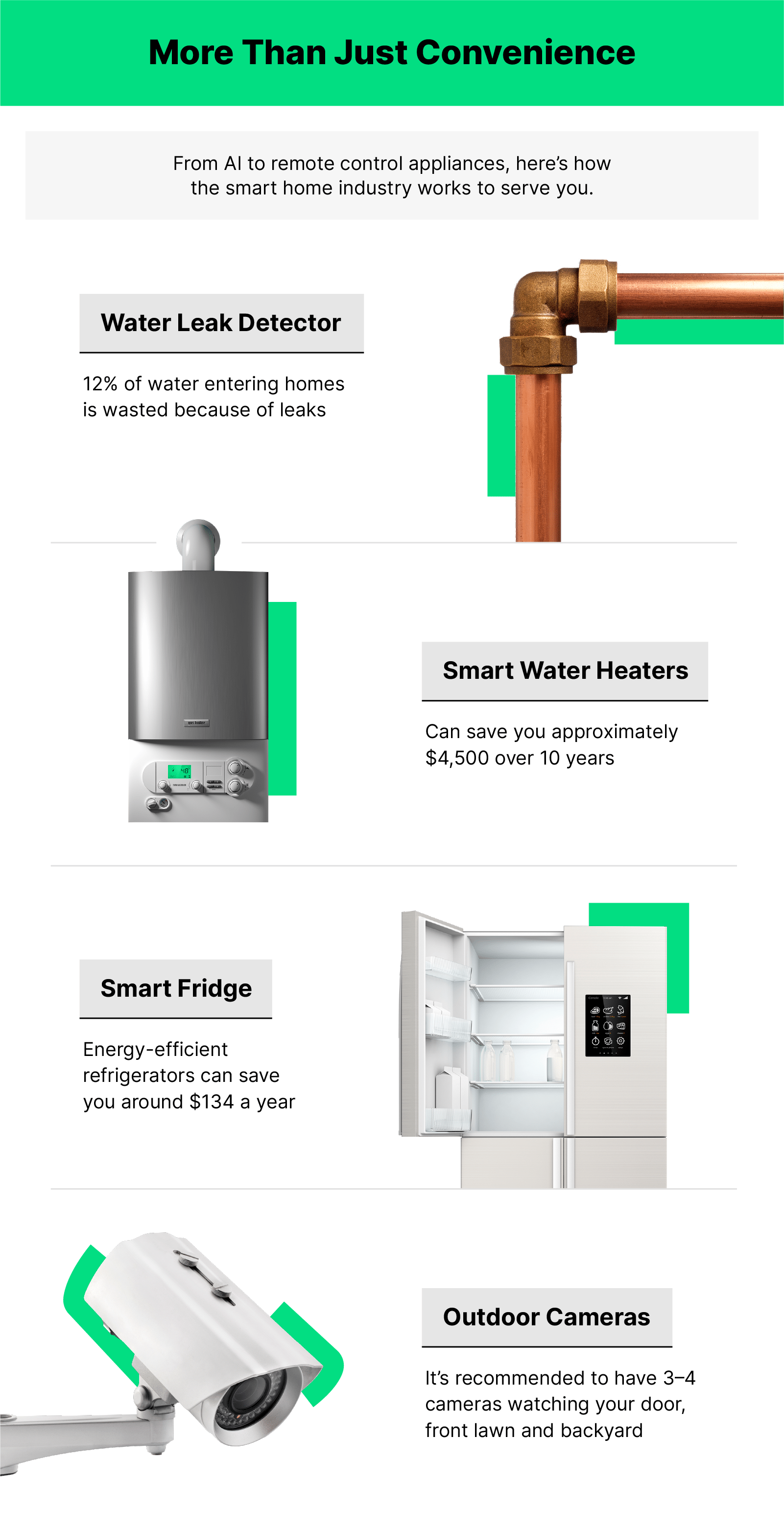
In addition to how much money it can save you by alerting you to small problems before they turn major, these devices can also help reduce your risk in the eyes of insurance companies. These smart home devices can lower your overall insurance premiums and even secure you more discounts for each device you install.
The history of smart home devices
The idea of smart home technology has been toyed with for decades. Even before the technology we have today, movies and TV shows were painting a future full of virtual assistants, houses that clean themselves and appliances that can talk. And while our reality may not look exactly like what was pictured in the movie Smart House (1999), it doesn’t fall terribly short.
The smart home industry began earlier than you might think, all the way back in 1898 with the invention of the first remote control. From there, tech companies began to look for more ways to automate their products and bring consumers the convenience they wanted with updated appliances and kitchen computers. While many companies were trying to tap into the market, this technology’s high price kept it inaccessible for many until the late ‘90s.
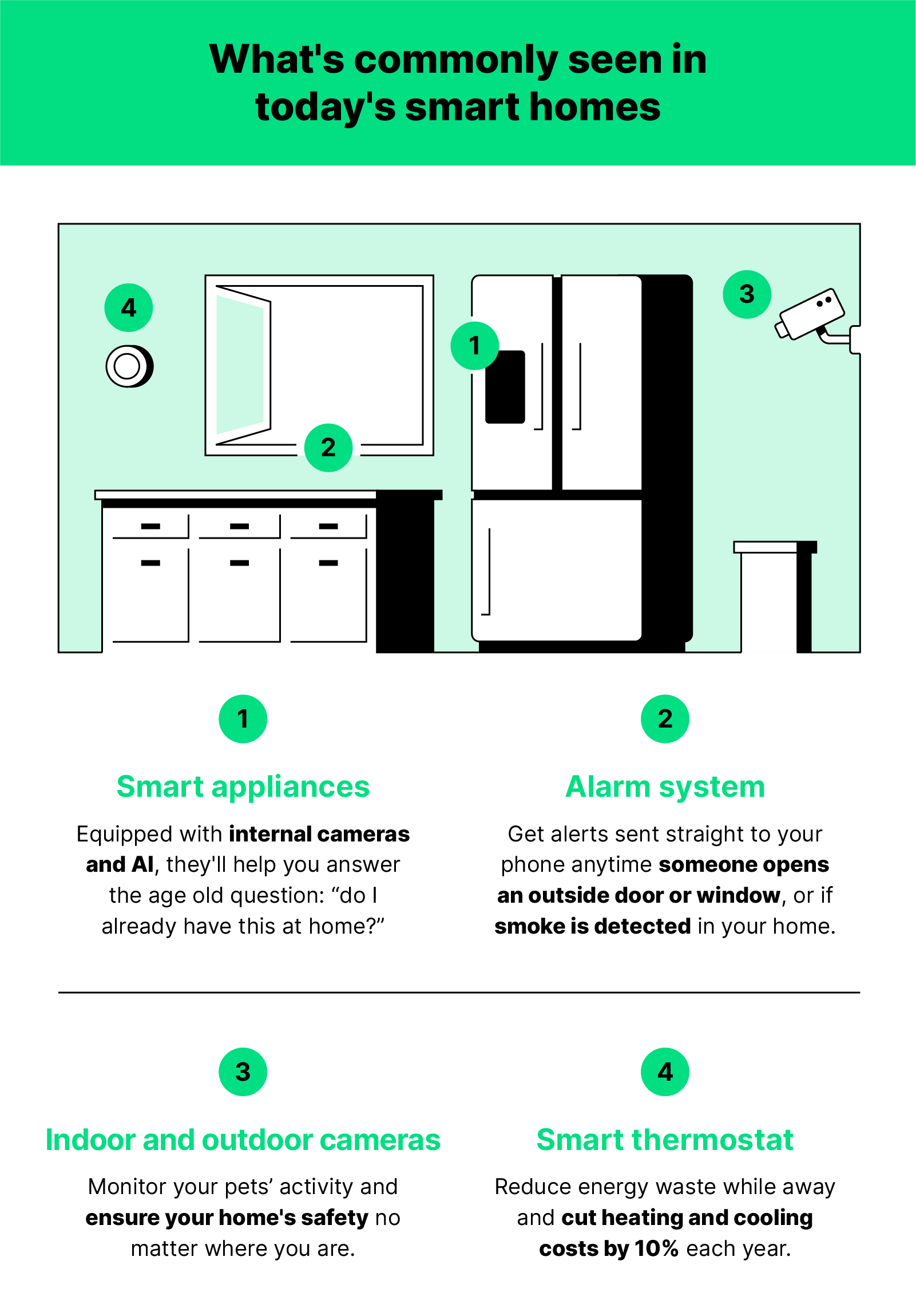
The most popular smart home products do have some similarities with the early predictions for the future. Smart speakers act like virtual assistants: setting timers, keeping track of appointments and playing music on request. Refrigerators are equipped with AI and cameras to let people know what they need to pick up at the store with ease. Even basic home features such as doorbells, toilets and piping have seen an upgrade, all in the name of convenience.
But the question remains: now that this tech is finally here, how will it grow and adapt to future needs?
A smarter future
In the years ahead, connected homes will only become more common. New home builds are already coming equipped with smart home automation, such as built-in security systems or voice assistants in every room. Those who are selling older homes are often leaving their smart devices intact to boost their property value. You can also expect to see more interconnectivity between smart appliances and more user-friendly interfaces as the market becomes more competitive moving forward.
Just like smart home devices, we’re here to streamline your home and make your life easier. After all, once you install all these devices, you want to be rewarded for it, right? Not only do we offer top-notch protection for your home (and the items inside), we also offer smart home kits and discounts if you already have some of your own.
Want to learn more? Just give us a call or check out our about page.




